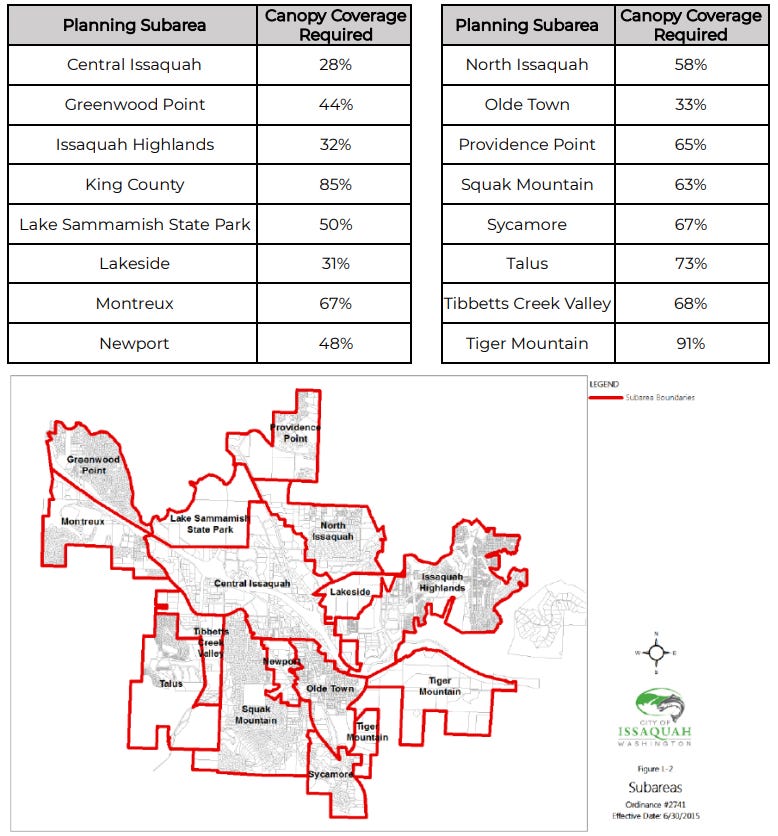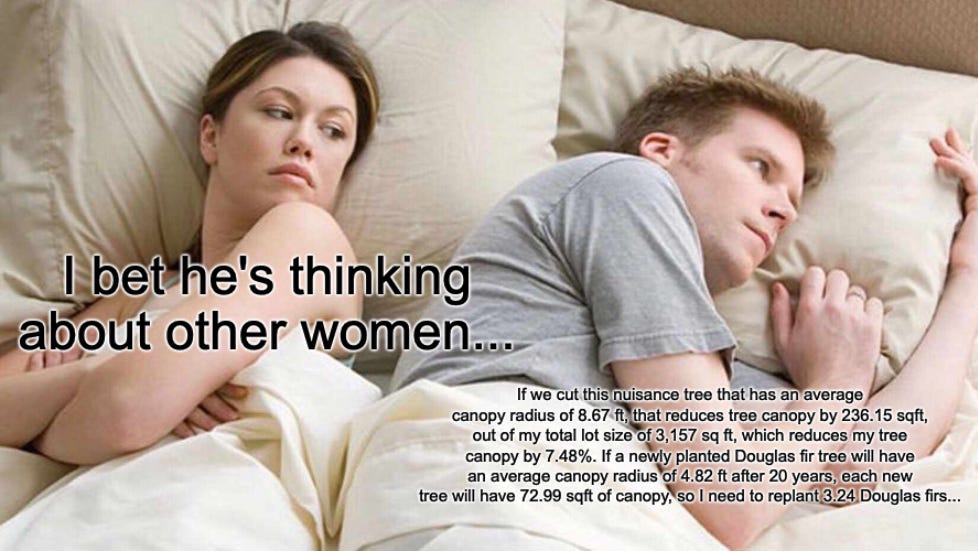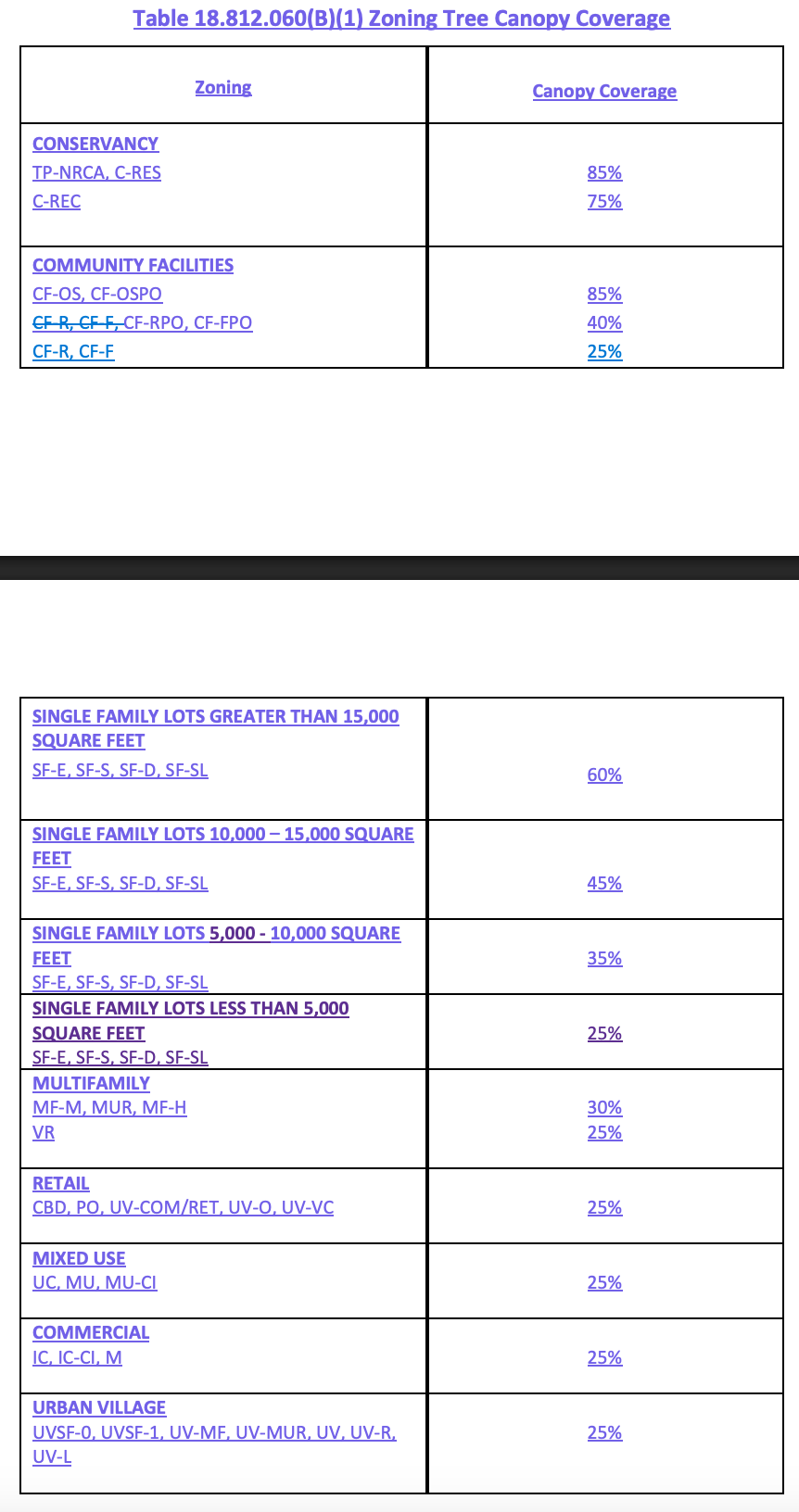All Trees Matter
How well-intended environmental policies go wrong. (For legal purposes, the title is a joke.)
The city of Issaquah, WA is nestled at the base of the foothills of the Cascades, foothills that we lovingly call the “Issaquah Alps.” The three “alps” that touch the city of Issaquah - Cougar, Squak, and Tiger Mountains - include over 100 miles of trails across over 15,000 acres of forested public land. So, we really love our trees here in Issaquah.

People here in Cascadia really, really do not like it when people cut trees willy-nilly. A few months ago, homeowners illegally cut 140 trees on King County park land to improve their views. This sparked mass outrage on the internet (and in real life too; I had a ton of people talk to me about this while I was out doorbelling). King County slapped the homeowners with a $7 million fine. People on the internet cheered. (The case is still working its way through the courts).
Trees are King
For a long time, the City of Issaquah took the approach to tree code design and enforcement that the #1 priority was preserving trees. In the words of our city administrator, we behaved in accordance with the idea that “trees are king.” As such, city officials would get into arguments with arborists hired by homeowners about whether or not a tree constituted a “nuisance tree” or a “hazard tree,” or neither, as that would have implications for whether a tree could be removed and how much the permit cost. Not really a great way for the city government to build trust with residents.
In 2023, Issaquah did a comprehensive overhaul of its entire land use code. This was an incredibly time- and labor-intensive multi-year process. And the tree code is part of the land use code, so it got a very comprehensive overhaul and became very, very, very complicated.
For example, if you were looking to remove a dead “significant tree,” defined as any tree with a diameter of 6” or greater, you would have to replant as many trees as are needed to maintain the amount of tree canopy in 20 years. You would have to hire someone to do this tree canopy calculation for you, which is not trivial. There were some cases where removing one (large) tree would result in the homeowner being required to replant SEVEN trees. And if the trees couldn’t be planted on-site, they would either have to be planted at an “approved off-site location,” or homeowners could pay a fee-in-lieu of $1,000 per tree to the City Tree Fund.
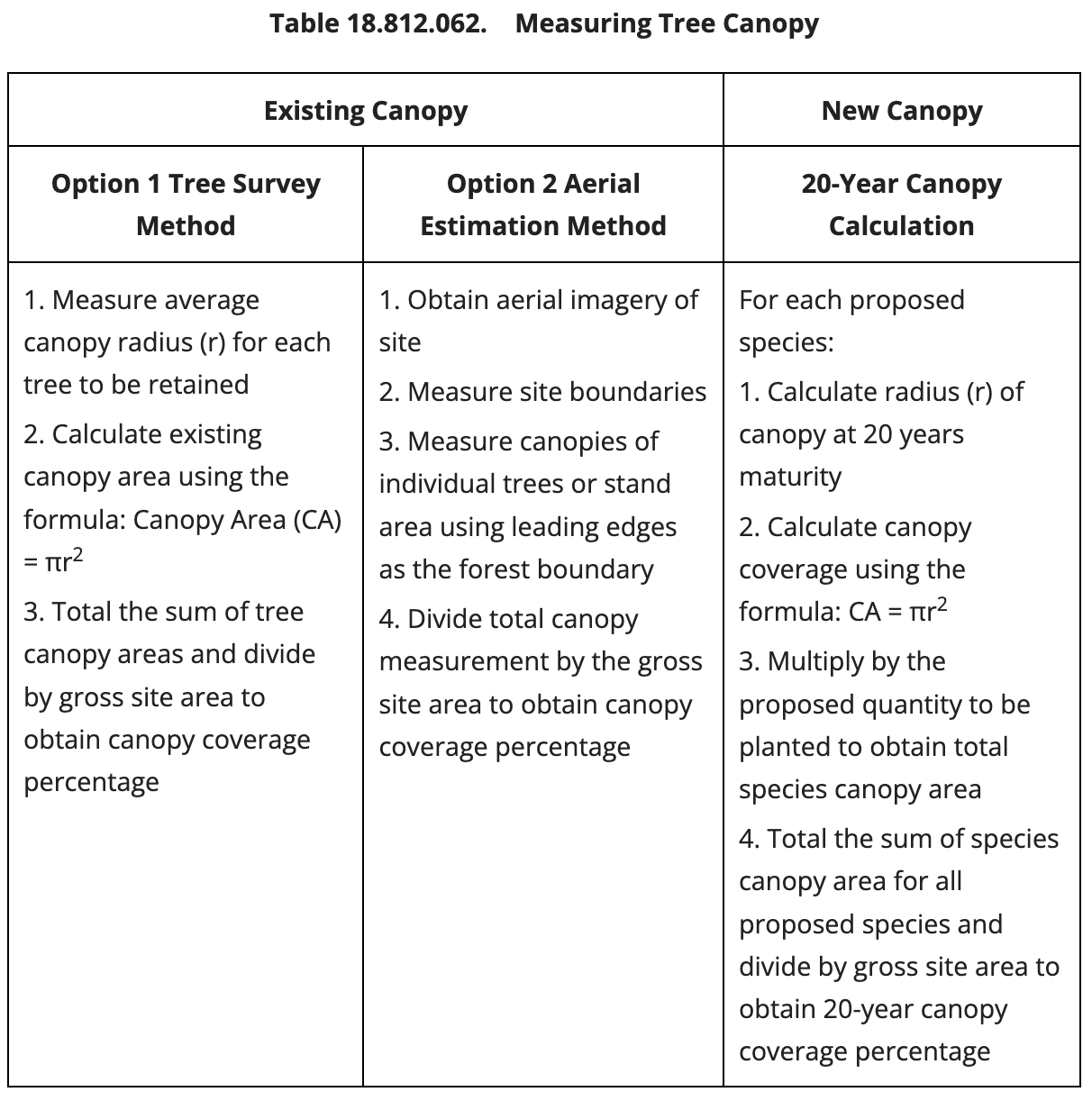
There are also complicated rules about how many trees need to be retained during development projects and how much tree canopy needs to be provided on the lot afterwards. Depending on your neighborhood, you have to hit the required canopy coverage for each neighborhood on your specific parcel.
For some neighborhoods, this leads to completely absurd results. In Talus (my neighborhood), nearly two-thirds of the land in our “planning subarea” is protected open space and has 95%+ tree canopy.1 According to this requirement (see chart below), the tree canopy goal for a 1,500 sqft parcel in Talus containing a single townhome would be 1,095 sqft, leaving only 405 sqft for your home. If you can’t replant trees on your lot (most people can’t), you can pay $1,000 per tree to be planted elsewhere.
I guess it would be good to note that you only have to hit the full tree canopy target if you’re doing development or redevelopment. If you’re not doing development, you merely have to replace the amount of tree canopy that was lost by cutting down the tree. Clear as mud.
Bomb Cyclone Aftermath
In November 2024, a so-called “bomb cyclone” hit Western Washington. Issaquah was particularly hard-hit, with hundreds, possibly thousands, of trees falling down all over the city, resulting in power outages that lasted for over a week for many residents (myself included). Many residents applied for tree permits to remove dead or dying trees, and ran straight into the morass of well-intended tree-preserving code.
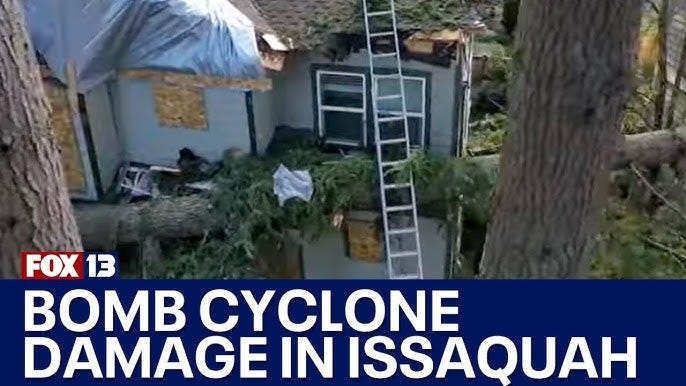
Since then, it seems like there’s been a real shift in the zeitgeist around tree codes. Now, even Issaquah’s Environmental Board and fervent environmentalists within the community acknowledge that this policy is unworkable. People are seeing their neighbors struggle to get permits to remove trees that are a threat to life or property, and faced with the prospect of paying $350 for a tree permit and $1,000 per tree for replanting, it becomes a whole lot more tempting to do the work without a permit. People in Issaquah generally want to follow the rules and do the right thing. But when the rules become too onerous, people may stop following them entirely, and choose to risk the consequences.
As a result, our planning department embarked on another journey to update the tree code, with the goal of providing more flexibility to deal with issues caused by the bomb cyclone. This opened up a further can of worms about the tree code in general, leading to a whole drawn-out public process to update the tree code, which included two meetings with the Environmental Board, two meetings with the Planning Policy Commission, before heading to the City Council’s Planning, Development, and Environment Committee, before finally heading to the full Council for adoption. (I’m exhausted even just thinking about the process).
We had our Planning, Development, and Environment Committee meeting last night about said tree codes. Most of the proposed amendments are certainly better and provide more flexibility than what existed in the tree code before. For example, now most trees only require a 1:1 replacement, and landmark trees, defined as those with a DBH (diameter at breast height) of 30” or more, require a 1:2 replacement. So yay, no more complicated canopy calculation to figure out how many trees to replant.
But oops, the canopy calculation comes into play elsewhere. If your lot meets the tree canopy targets in the new code, then you don’t have to replant. I guess that’s nice. These canopy targets are also no longer based on neighborhood, they’re based on zoning and lot size. Even though this is not an ideal solution, this would at least provide temporary relief for some homeowners. For example, the owner of a 12,000 sqft lot on Squak Mountain who would still have 50% tree canopy after removing their dead trees would no longer have to replant, as their new canopy target is 45% instead of 63%.
Ultimately, though, all we’ve done so far is solve the immediate problems in front of us. We need to step back to have a more basic, fundamental discussion and ask: what is the purpose of this policy in the first place?
What’s the Goal Here, Anyway?
Good policymaking is the art of balancing competing priorities and making clear-eyed decisions about tradeoffs. Unfortunately, we often fail to acknowledge these tradeoffs. For example, look at the “Purpose” of Issaquah’s tree code:
B. This chapter seeks to conserve the numerous benefits that trees provide to the community, to increase tree canopy coverage, to mitigate where loss of trees cannot be avoided, and to provide for the removal of trees, including hazardous trees. Specific objectives of these standards are outlined as follows:
1. Avoid or limit the removal of significant trees, landmark trees, heritage trees, and any trees within critical areas except where they are deemed hazardous or a nuisance;
2. Maintain and enhance tree canopy coverage to reduce the heat island effect, improve air quality, improve water quality, improve biodiversity, minimize erosion and stormwater runoff, provide beneficial carbon sequestration, and preserve the natural forested character of the City;
3. Mitigate the economic, environmental, and aesthetic consequences of tree removal through on-site and off-site tree replacement to enhance tree canopy throughout the City;
4. Promote project designs that utilize existing viable trees in the landscape, and allow replacement of native tree species;
5. Require proper tree selection and adequate spacing for the healthy growth and root development of trees;
6. Provide measures to protect trees that might be impacted during construction; and
7. Protect members of the public and public resources and facilities from injury, loss of life, property damage, or financial losses.
#1-6 are basically some version of “keep as many trees as possible” (after all, the tree code’s full name is “tree preservation ordinance”). #7 is about safety for life and property. But there are clearly some other objectives that we’re trying to balance here, such as:
Ensuring the tree code is reasonable for people who want to build denser housing (apartments, townhomes, stacked flats), especially in Central Issaquah.
Making the process of getting tree permits simple and viable for homeowners, builders, and land managers.
Keeping our community safe from wildfires (although that could arguably fall under #7).
Without acknowledging and defining our goals, it’s pretty difficult to make policies that actually work. We need to make policy that actually considers the system as a whole - including the impact of infill housing on climate and forests - rather having a single-minded focus on “preserving trees” at all costs. And, we also need to take seriously the issue of customer experience when residents interact with city government, including when they’re getting tree permits.
There were some other ideas proposed that I’d like to see us consider more in depth, including:
Temporarily waiving replanting requirements following emergencies like the bomb cyclone.
Having a city arborist on staff to review tree permits and serve as a single source of truth, rather than requiring homeowners to hire an external arborist. This would save money for homeowners and save time and headaches for everyone.
Potentially allowing removal of “non-significant” (i.e. under 6” DBH) trees without a permit. Other cities allow this to some extent; should we?
Taking public tree canopy much more seriously (i.e. planting trees in city-owned street right-of-way), rather than micromanaging what people do with trees on their own private property.
At the end of the day, if we’re serious about environmental conservation, we need more homes in cities. If we can’t remove one tree to redevelop a single-family home in Olde Town Issaquah into a 4plex, instead, we’ll end up clear cutting 100 trees to build single family homes out in places like Black Diamond. And if people live in Black Diamond instead of Issaquah, they’ll be commuting an extra 45 miles per day. Oh, and by the way, the emissions from a mere 45 car-miles are equal to the carbon sequestered by a tree for THREE YEARS.2 Creating policies that make it harder to cut that one tree in Issaquah is, quite literally, missing the forest for our local trees. We can do better.
The reason we have so much protected open space is that we made an intentional choice to concentrate denser development on a smaller portion of the land, while setting aside the rest of the land for conservation. That makes it extra ironic that we are applying neighborhood-wide tree canopy targets to individual lots.
I used the EPA emissions calculator based on 2 gallons of gasoline, which corresponds to ~45 miles traveled in a gas powered car or 0.3 trees grown for 10 years (which I assumed to be roughly equivalent to one tree grown for three years). Issaquah is about 22 miles from Black Diamond.


